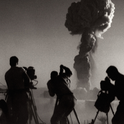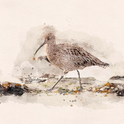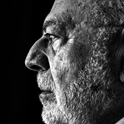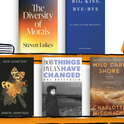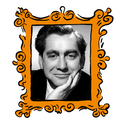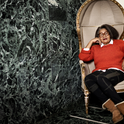Anyone for conceptual calligraphy? Chinese artist Xu Bing's first major British exhibition at the Albion gallery in London displays large sheets of what looks like Chinese calligraphy. Yet each calligraphic sign, almost always painted in a light black hue, is artfully composed of the letters of one English word. One would have to spend an exhausting month in the gallery to decipher this strange language, which Bing calls "square word calligraphy." Pressed for time, I availed myself of some information in the gallery offices. One work is titled, in calligraphy of course, Quotation from Chairman Mao—and there follows a particularly gormless pronouncement from the late communist leader, beginning: "Works of literature and art, as ideological forms, are products of the reflection in the human brain of the life of a given society…"
Xu has made innumerable text-based "pictures" of this kind, and the gallery has many more on display. In some he "translates" the poetry of Walt Whitman. In others, the texts are written on stone. In another series, he has painted long panoramic landscapes with his simple black brush, apparently in a traditional style, as if on a scroll. Look closely, however, and each element of nature is composed out of different calligraphic signs—one for forests, another for streams, a third for mountains. Landscripts, the artist calls them. Xu combines ancient Chinese tradition, recent communist history and western culture—a recipe that has slotted suspiciously well into western art criticism and art markets. It poses a conundrum for critics today, typical to much contemporary Chinese work: this is clearly highly calculated art—but is the calculation part of its mastery?
A whole sub-genre of conceptual art, based on words, developed in the west in the 1960s and 1970s. Bruce Nauman made drawings and neon signs which illuminated "disturbing" links between words, like Violins/Violence. Lawrence Weiner abandoned actually making works of art, instead writing descriptions of works in large letters on gallery walls, inviting the viewer to imagine them, such as: "One quart exterior green industrial enamel thrown on a brick wall (1968)." Richard Prince, whose retrospective opens at the Serpentine in June, wrote suburban American jokes in the middle of abstract paintings. Xu presents us with a Chinese version of this sub-genre.

Xu is one of many commercially successful Chinese artists who combine the strategies of contemporary western art with traditional Chinese elements. Wang Guangyi, for example, paints heroic workers in a communist-era social realist poster-style, but decorated with brand logos like that of Coca-Cola. Zhang Xiaogang produces perhaps the best-known images of this group of artists, painting large-scale portraits of two or three figures in the style of old, cultural revolution-era photos. One of his paintings was recently auctioned in Hong Kong for $6m.
The art of Wang and Zhang is heavy-handed, formulaic and sentimental. It will retain historic value, but is unlikely to command much respect in the long term. Yet Xu Bing is different. Why?
For one thing, his art is painfully difficult to look at: these are not big, bright easily understood paintings to hang above the sofa. Second, his work, unlike that of his peers, taps into a thousand-year-old Chinese tradition which combines painting and writing, pre-dating our language-based conceptual art. Third, the 53-year-old artist has an important historic interest in politically altered language. During Mao's cultural revolution, the Chinese government began simplifying the characters of the Chinese language as part of a programme to improve literacy. Xu himself became a victim of the cultural revolution in 1975, when he was exiled to the countryside for two years.
Finally, Xu's work is not just contemporary art, it is contemporary full stop—as Book from the Ground, a computer-based work in his London exhibition, indicates. This marvellous project uses universally recognisable icons and emoticons, and a software programme which translates any language, to create a new language of signs. These vary, wittily, from weather-forecasting symbols, brand names like Wrigley's, faces with expressions (the sign for "young" is a round face with a dummy for a mouth), the outlines of an iPod, the litter sign of a man throwing something into a bin, hands pointing, and aeroplanes taking off and landing. The point is that it's not quite art—it's too useful for that—and yet it is something produced by the anonymous collective of internet users and an artist. It might just yet become a new, widely used written language.
